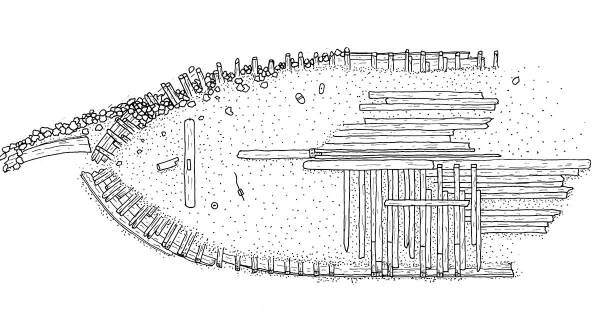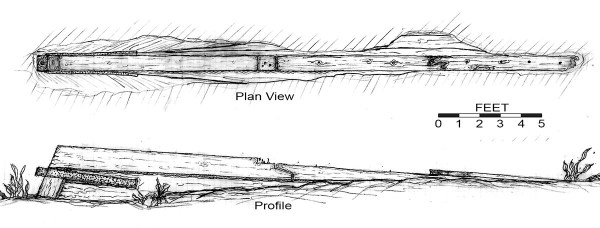One of the vessels in the Pine Street Canal Breakwater site has been identified through the historical record and the preliminary documentation of the extant remains as the 1850 schooner Excelsior.
The October 17, 1885 issue (4:1) of the Burlington Free Press reports that “The spars of the old schooner Excelsior, which was sunk at the mouth of the cove [Pine Street Canal] last fall, were removed yesterday. This was one of the largest schooners that used to ply on the lake.”
Excelsior’s last enrollment papers provide the following information on the vessel:
Permanent Enrollment (P.E.) No. 4 issued at Burlington on May 20, 1884, which lists Mary A. Kiernan of Burlington as owner, and Henry Dupee as master. The vessel (Official Number 8092) was built at Willsboro in 1850. Her enrollment describes her as having one deck and two masts and being a schooner-rigged vessel with a moulded bow, plain head, and a transom moulded stern. Her measurements were: length 87ft (26.5m), breadth 25ft (7.6m) and depth 7ft (2.1m). Gross tonnage was listed as 99.08 and net tonnage as 94.13.
The 1990 reconnaissance survey reported the wreck as the “lower portion of a vessel hull”. The 2004 examination found what was earlier thought likely to be a canal boat wreck, was instead that of a mid to late nineteenth century lake vessel. The vessel is broken into two sections. The forward portion of the hull lies on the northern side of the northern Pine Street Canal breakwater. The stern is located west of the 1893 breakwater. It is believed that the stern of Excelsior was ripped from the vessel and deposited in its current location when the basin was reopened in 1960/1961.
Bow Section
The forward part of the hull has a preserved length of 52ft 2in (16m) and a beam of 23ft (7m). These remains consist only of the lower 2 to 4ft (61 to 122cm) of the hull. Toward amidships the boat is preserved only to the turn of the bilge, while at the bow the remains project 3ft (.91m) above the bottom with an estimated 1ft (30.5cm) or so buried. The starboard side of the boat is partially covered with rubble from the collapsed breakwater.
The stem is still present, although it is detached from the hull, and is partly buried by rubble. It is 9ft 2in (2.75m) tall with an iron band on its forward face.
A saddle maststep runs transversely across most of the breadth of the bow. It is located 15ft (4.5m) aft of the presumed original location of the stem. It has a rectangular hole for accepting the base of the mast. The mast stump lies in the bottom of the hull just forward of the saddle. The forward position of this step helps confirm the vessel’s identification as a schooner.

Preliminary archaeological drawing of the forward half of the schooner Excelsior (Adam Kane, LCMM Collection)
The preserved length of the centerboard trunk is 20ft (6m), although its after end is no longer extant. The trunk is set just to the starboard of the boat’s centerline. The base of the centerboard is still in the trunk.
The boat has a keelplank rather than a true keel. The underside of the keel has a thin layer of sacrificial planking, or false keel. The keelson is at least 12 in (30.5cm) moulded and sided. The frames are approximately 6in (15cm) moulded and sided. The turn of the bilge is rounded. Planking is preserved to the turn of the bilge at the stern of the wreck, with more preserved toward the bow. The shape of the hull is flat bottomed with a relatively bluff bow. Construction is plank on frame with iron fasteners.
Although the hull contained significant quantities of modern trash, researchers did observe several rigging elements including a snatch block, a block and a sheave. Portions of the starboard side of the boat are buried by rubble from the breakwater.
Stern Section
Located outside of the 1893 breakwater is a section of vessel wreckage that is believed to be the stern of Excelsior. The remains consist of a portion of the keel, sternpost, shoe, gudgeon, and planking. Interestingly, the stern assembly is upside down and it is unclear how much more of the structure is buried in the lake bottom sediments.

Plan view and profile of the Excelsior’s inverted stern section (Chris Sabick, LCMM Collection)
The bottom of the keel is exposed for 25ft (7.6m) and is composed to two timbers scarfed together with a short diagonal scarf. The bottom face of keel was originally protected by a 2in (5cm) thick false keel. A 6ft 4in (1.9m) section of the false keel remains, and is similar to the false keel in the bow section. The aft keel timber does not have a false keel, but its forward end is notched to seat the after end of the false keel, which originally overlapped the scarf joint. The aft keel timber, which is 10ft 8in (3.3m) long, is tapered, measuring 10in (25.4cm) molded and 8in (20.3cm) sided at its forward end and swelling to 14in (35.6cm) molded at its terminus. The forward keel timber is 8in (20.3cm) sided and molded.
A 12in (30.5cm) molded and 8in (20.3cm) sided stern post is mortised into the aft end of the keel. The forward face of this timber has a 2in (5cm) deep rabbet to accept the hood ends of the hull planking. Only portions of two hull planks are visible above the mud line. These planks are 2in (5cm) thick and 8in (20.3cm) wide and are fastened with iron spikes. An iron gudgeon is also visible on the stern assembly. The iron gudgeon is fastened through the sternpost and lowest hull plank with iron bolts and has a 3in (7.6cm) diameter opening to accept the pintle.
While it cannot be conclusively stated that this stern wreckage belonged to the schooner found inside the breakwater, its dimensions, similarity in construction, and location suggest that it did. Further excavation and documentation of both hull components will allow for a conclusive determination.
Excelsior Historic Analysis
In determining that the wreckage of VT-CH-796 was the schooner Excelsior, researchers examined the information known about individual schooners on Lake Champlain. There were four or possibly five, nineteenth century lake schooners that had a beam of 23ft (7m) or greater that were considered, but Excelsior was the best fit for dimensions and history:
Daniel Webster, a lake sloop built at Burlington, VT in 1837, having dimensions of 86ft by 25.75ft by 6ft (26.2m by 25.8m by 1.83m). She was reported to be schooner rigged in 1858. Her beam of nearly 26ft (8m) seems to be a little wide and her depth of 6ft (1.8m) a little shallow. (The 9ft 2in [3 m] stem on VT-CH-796 indicates a fairly deep vessel). The unusual transverse mast step has not been seen before in Burlington built vessels. What became of the Daniel Webster is not known.
- Gen. Scott, a schooner built at Champlain, NY in 1839, had dimensions of 80ft by 26ft by 5ft (24.4m by 8m by 1.5m). This vessel’s beam is probably too wide and depth too shallow. The Gen. Scott’s enrollment papers were surrendered at Burlington in 1872, and the vessel was reported as being abandoned (location and actual date not given).
- T.D. Chapman, a schooner built at Whitehall, NY in 1848 with dimensions of 106.5ft by 25.3ft by 6.2ft (32.5m by 7.7m by 1.8m). This vessel is probably too long, but the beam and depth are reasonable. No record of the vessel’s service or disposition has been found to date.
- American, a schooner built at Willsboro, NY in 1848 with dimensions of 88ft by 24ft by 6ft (26.8m by 7.3m by 1.8m). Although dimensions are reasonable (beam and depth probably a little small), the schooner was reported beached for breaking-up on the New York shore in 1879.
- Excelsior, schooner built at Willsboro, NY in 1850 with dimensions of 87ft by 25ft by 7ft (25.5m by 7.6m by 2.1m). The beam is consistent with the probable original beam of VT-CH-796 and the depth, the deepest of the other three or four named schooners, probably is reasonable for a vessel with a stem of 9ft (2.7m).
Based on the historical record, in particular the report of its sinking and abandonment, the location in which it was found, its dimensions, probable age, type of construction, probable schooner rig and a comparison with other lake schooners, the vessel was identified as Excelsior.
Excelsior’s Career
The schooner Excelsior was one of Lake Champlain’s largest nineteenth century commercial sailing vessels. Brief glimpses into the schooner’s 35 years of service on Lake Champlain are provided by sporadic newspaper accounts and its enrollment papers.
Excelsior was built in Willsboro, New York in 1850 (O/N 8092). Its enrollment documents describe it as a wooden vessel with one deck, two masts, a moulded bow, pain head and transom moulded stern. Its enrollment documents between 1870 and 1884 give her measurements as 87ft (26.5m) long, 25ft (7.6m) in beam and 7ft (2.1m) deep, while slightly larger measurements of 25.5ft (7.8m) in beam and 7.2ft (2.2m) deep are reported between 1868 and 1870.
Excelsior’s first known enrollment was issued in April 1865 at Plattsburgh and surrendered there in May 1868 because of a change in ownership. The vessel’s new owner was C.D. Landon of Whitehall, New York with O. Landon as the schooner’s master. Excelsior’s 1868 enrollment was surrendered at Plattsburgh in July 1870 because of a change in ownership. The next owner was W.T. Foote, with O. Landon continuing as its master. In 1872 Excelsior changed hands again with Rufus C. Landon of Whitehall as the owner and master. In 1879 another enrollment was issued because of a change in ownership and district change, however, Rufus Landon is still listed as the boat’s owner. The port of hail is Whitehall, while the master is Henry Dupee. Excelsior’s last enrollment was issued in 1884 and surrendered in Burlington the following year. The vessel was “abandoned as unfit for service.” The schooner’s last owner was Mary A. Kiernan, while Henry Dupee was still the master.
In addition to Excelsior’s enrollment documents, researchers have located a number of newspaper accounts of the schooner’s career.
1860
Made first trip of the season between Burlington and Port Kent on 28 March 1860.
1866
Made last trip of the season between Burlington and Port Kent on 21 January 1866.
1870
The EXCELSIOR took advantage of a favorable wind, and started for Port Henry yesterday, carrying several large boilers for the iron company at that place.
1881
The schooner Excelsior has gone into winter quarters at Plattsburgh. She was built at Willsboro Bay in 1853 by Captain Landon and is 110ft (33.55m) long and 28ft (8.5m) wide – one of the largest sailboats on the lake.
1882
The schooner Excelsior, loaded with stone, made her last trip to Port Henry last week.
1883
The old schooner EXCELSIOR, well known to many of our readers, is again engaged this season freighting limestone from Westport to the Cedar Point furnaces. She is one of the very oldest vessels on the lake, and is commanded by Capt. Dupry, who has been on board of her every season for 22 years.
1885
The spars on the old schooner Excelsior, which was sunk at the mouth of the cove last fall, were removed yesterday. This was one of the largest schooners that used to ply on the lake.
For historical references and sources see:
Adam I. Kane, A. Peter Barranco, Joanne M. DellaSalla, Sarah E. Lyman and Christopher R. Sabick, Lake Champlain Underwater Cultural Resources Survey, Volume VIII: 2003 Results and Volume IX: 2004 Results. Lake Champlain Maritime Museum, 2007.
Adam Kane, Christopher Sabick and Sara Brigadier, Lake Champlain Underwater Cultural Resource Survey, Volume VI and Volume VII, Lake Champlain Maritime Museum, 2003.
